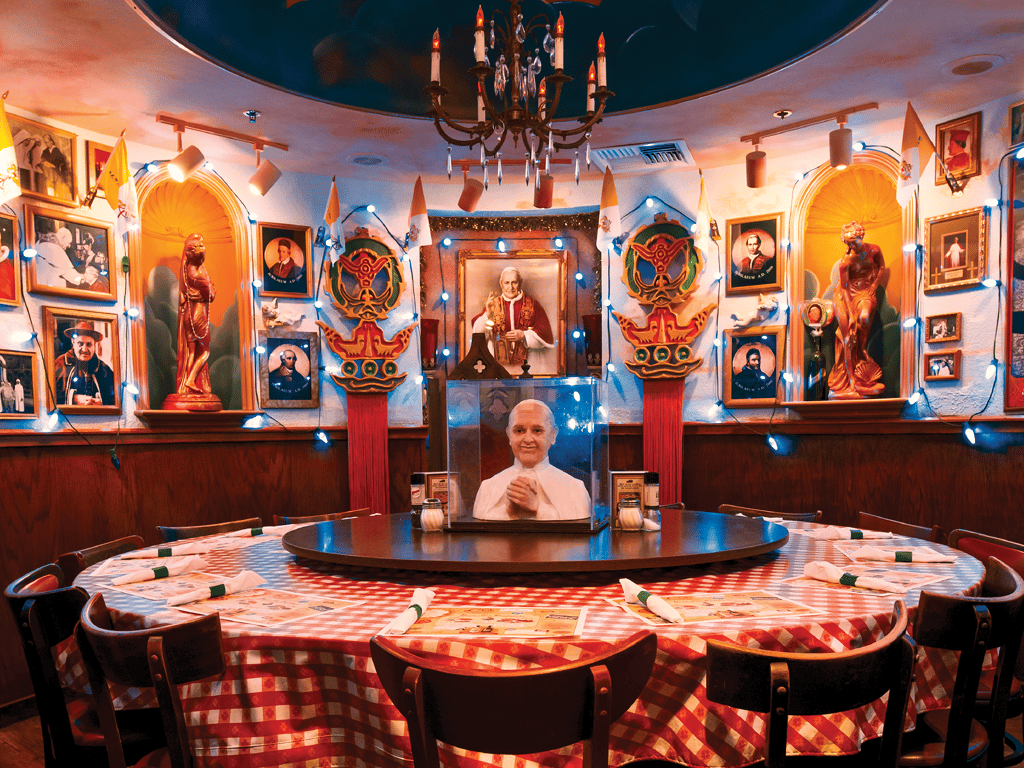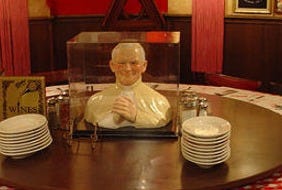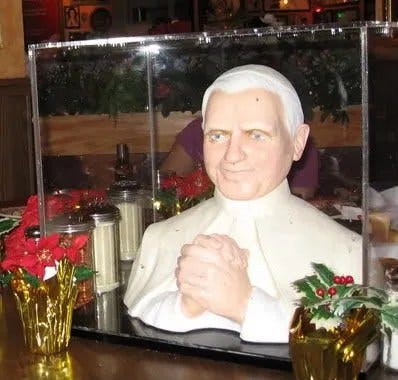In a previous post, I noted the many questions I was asked by journalists about Pope Francis, the conclave process, and what predictions I might have about the next pope. These were all reasonable questions, and I do wonder myself about who the next pope will be. But even that was not the biggest question I have thought about since Francis died.
My question was “what happens with the Pope Room at Buca di Beppo?”

For those unfamiliar, Buca di Beppo is a chain of Italian restaurants that serves food family style, i.e. large portions meant to be shared. The walls of the restaurants are covered in Italian-American kitsch, with plenty of Italian flags, photos of people eating pasta, and posters of Sophia Loren.
But the most famous of all is the Pope Room. This circular room features a large table that seats 12-16 (18 if you’re really cozy). In the middle of the table is a bust of the current pope, enclosed in an acrylic box, seated atop a lazy susan.
But because the bust is of the current pope, the sede vacante period raised three main questions for me:
What does Buca di Beppo do with the bust of the pope when he dies or resigns?
What happens to the busts of the old pope?
Where do busts of the new pope come from?
I wanted to find out.
The first stop in my research was Google. I did not find any sort of corporate policy or protocol from Buca di Beppo itself, but I did find references to what happened after Pope John Paul II died on April 2, 2005. According to UPI, corporate asked all the restaurants to return the John Paul II busts to headquarters. The story also cites one of the restaurant managers saying that the bust would be replaced with a “generic pope,” presumably while waiting for a bust of the next pope to be carved.
Coincidentally, while talking about this story with my colleague Frank Orlando, he relayed to me that he had in fact been in a Buca di Beppo Pope Room mere days after John Paul II’s death. Frank, a passionate Michigan State fan, went to see both the mens and womens basketball teams in the Final Four, which was from April 2-5, 2005. Before the women’s final game, he and his friends ate at the Buca di Beppo in Indianapolis, where he saw the bust in the Pope Room covered with a cloth out of respect. Frank was uncertain whether the manager had already removed the bust itself and placed a cloth over the plastic case, or whether the case itself was covered.
Overall, this seems to me a good, respectful way to observe the sede vacante period. News reports suggest some customers were unhappy with the decision, but it seems to me a good model to follow for a restaurant that prominently features a bust of whomever the current pope is.

Unfortunately, further Googling did not turn up anything about the 2013 conclave that elected Pope Francis after Benedict XVI’s historic resignation, nor have I seen anything about what Buca was doing after Pope Francis’ death.
Since Buca di Beppo is a chain, and the 2005 story indicated corporate dictated what should happen, I decided to contact Earl Enterprises, the restaurant group that acquired Buca in 2008 through their subsidiary, Planet Hollywood. On reaching their headquarters in Orlando, I was promptly informed that Earl Enterprises no longer owned Buca di Beppo, and the website contact I was looking at was out of date. Apparently Buca had filed for bankruptcy in August 2024, partly due to fallout from the COVID-19 pandemic, and then were bought that November by the private equity firm Main Street Capital.
So I called Main Street Capital. On reaching their main offices, they at first did not understand my question about Buca di Beppo and the Pope Room, and I had to be transferred to someone else. This new person also did not understand; he even expressed surprise that Buca di Beppo had a Pope Room. He then helpfully explained that, as a private equity company, they mostly just owned the restaurant chain but didn’t really have any operational insight into what goes on. Obviously they had no idea where the old pope busts go or the new pope busts come from. He suggested I talk to a restaurant manager instead.

I began calling actual Buca di Beppo locations and asking for the managers. The two I was able to speak with were quite friendly and happy to take my three questions, slightly reframed:
Does Buca di Beppo remove the bust of the pope when he dies, or do you wait for a new pope?
What happens to your old pope busts?
Where do your new pope busts come from?
The essential answer that both managers gave me to all three questions was “whatever corporate tells us.” They had no idea. One manager said he had been on a conference call about it, but the call did not resolve anything. Neither of the managers I spoke with had been with Buca in 2013, so they didn’t have any institutional memory from the previous conclave.
When I spoke with them, it was about a week after Francis died, and at that point they (1) had no instructions on removing or covering the busts of Francis, (2) no direction on what to do with the old busts, or (3) any information on when a bust of the new pope could be expected. This was clearly different from 2005, and it looks like what happened in 2005 was not made into an official corporate policy.
One manager did note that when numerous Buca locations were closed between 2016 and 2019, many of them sold their busts (possibly on eBay).1 The other manager thought the pope bust they had wasn’t even Francis, but an older Benedict XVI one.2 Both managers expected new busts would be distributed from the corporate office, with one of them comparing it to any other equipment or memorabilia in the restaurant.
At this point I felt stymied. Having not been in a Buca di Beppo pope room in quite some time, I decided to look online for more images of the various busts. In doing so, I came upon a curious photo of a table covered with Pope Francis busts. This led me, unexpectedly, to Glenn Terry, the sculptor responsible for the busts of Benedict XVI and Francis.

I called Glenn, hoping he could answer some of my questions, but he was teaching so I left a message. I was pleasantly surprised when he called back a few hours later and talked with me about his work for Buca.
This work began when he was commissioned by a statuary company to sculpt a bust of Pope John XXIII in the early 2000s, not knowing the statuary company was itself commissioned by Buca.3 Glenn only learned of this when Buca contacted him directly in 2005, commissioning him to make around 100 busts of the newly elected Pope Benedict XVI. Later, after Benedict’s resignation, Glenn was again commissioned to make the Pope Francis busts.
He would first sculpt the bust in clay, and from there he would make a mold for the bust. From the mold, busts were cast in resin. He would then spend time cleaning and correcting these resin casts, cutting off small tags or fixing bubbles in the material. Once the busts were corrected, he would hand paint each and every bust, as he thought whomever had painted his John XXIII busts had done them too “garishly.” The whole process, from the initial carving to completion, took him maybe 3-6 months. He reused some of his work on the Benedict bust for Francis, primarily in the shoulders, but he changed the hand gesture, the ring, and (obviously) the head.
With gratitude to Glenn for sharing his experience and artistic process, I had three further questions for him. First, had he been contacted about doing the bust of the next pope? As of when we spoke, he had not heard from Buca’s, but he said he would be happy to do so. Next, I asked him if he remembered what his total commission was for the project; like any true artist, he told me “It’s one of the least important things for me.” Finally, I asked if he had ever eaten in the Pope Room himself. No, he said, but he had eaten at a Buca di Beppo, but not with a large enough party for the Pope Room. He did get to look in, though, and said it “was fun, nice to see [his handiwork] in that context.”

So let’s return to my three questions.
What does Buca di Beppo do with the bust of the pope when he dies or resigns?
In 2005, they covered or removed the busts of John Paul II, at least for a time. It would have taken a few months to get the new Benedict XVI busts, and I doubt the Pope Room was pope-less for that long. I can’t find anything on what they did in 2013, and the story in 2025 is still in wait and see mode.
What happens to the busts of the old pope?
It seems like they are usually sent back to corporate headquarters, but have in some cases been sold or donated. My own efforts to acquire one of the Pope Francis busts have so far been stonewalled.
Where do busts of the new pope come from?
In the previous two conclaves, they were sculpted by Glenn Terry. I’m not sure who originally sculpted the John Paul II busts, and it remains to be seen if Glenn will do the next pope.
Is the issue of Buca di Beppo’s popes and what happens in the Pope Room important? No. I’m highly confident it was not a matter that came up during the cardinals’ general congregations these last two weeks.
Is it entirely idiosyncratic to me? Possibly, although one manager I spoke to did say someone else had called about the pope busts a few days before I did. So that makes at least two of us.
Am I satisfied with the answers I got? No, but I did really enjoy talking with Glenn the sculptor. And while it’s been years since I last ate in a Buca di Beppo Pope Room, perhaps a few months after the conclave is over and there’s a new pope, I and 11-15 of my Okeydoxy readers can meet up around the big table, share some family style spaghetti and meatballs, and pay our respects to the new pope bust.
I did find one Facebook post from 2023 of someone who claimed to find a Pope John Paul II bust at a yard sale.
Looking at recent photos of the Pope Room from that restaurant, I can confirm they actually are the Francis busts.
You can see the clay sculpture of his John XXIII just above the photo of all the Francis busts on his webpage.



